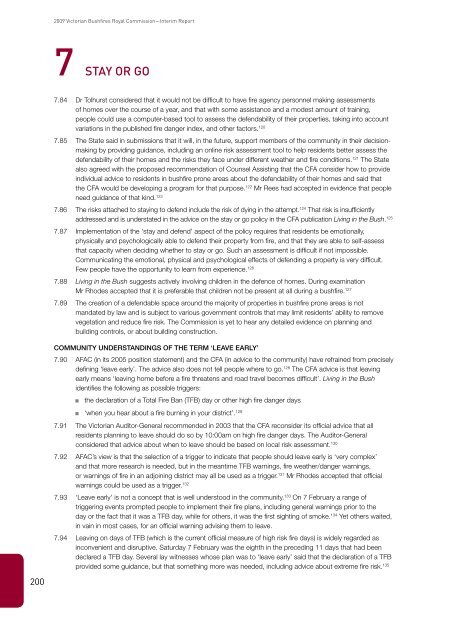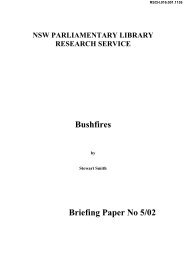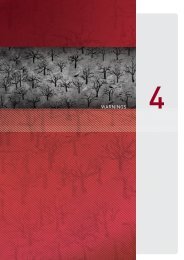Chapter 7 - Stay or go - 2009 Victorian Bushfires Royal Commission
Chapter 7 - Stay or go - 2009 Victorian Bushfires Royal Commission
Chapter 7 - Stay or go - 2009 Victorian Bushfires Royal Commission
Create successful ePaper yourself
Turn your PDF publications into a flip-book with our unique Google optimized e-Paper software.
<strong>2009</strong> Vict<strong>or</strong>ian <strong>Bushfires</strong> <strong>Royal</strong> <strong>Commission</strong>—Interim Rep<strong>or</strong>t<br />
7 <strong>Stay</strong> <strong>or</strong> Go<br />
7.84<br />
7.85<br />
Dr Tolhurst considered that it would not be difficult to have fire agency personnel making assessments<br />
of homes over the course of a year, and that with some assistance and a modest amount of training,<br />
people could use a computer-based tool to assess the defendability of their properties, taking into account<br />
variations in the published fire danger index, and other fact<strong>or</strong>s. 120<br />
The State said in submissions that it will, in the future, supp<strong>or</strong>t members of the community in their decisionmaking<br />
by providing guidance, including an online risk assessment tool to help residents better assess the<br />
defendability of their homes and the risks they face under different weather and fire conditions. 121 The State<br />
also agreed with the proposed recommendation of Counsel Assisting that the CFA consider how to provide<br />
individual advice to residents in bushfire prone areas about the defendability of their homes and said that<br />
the CFA would be developing a program f<strong>or</strong> that purpose. 122 Mr Rees had accepted in evidence that people<br />
need guidance of that kind. 123<br />
124<br />
7.86 The risks attached to staying to defend include the risk of dying in the attempt. That risk is insufficiently<br />
addressed and is understated in the advice on the stay <strong>or</strong> <strong>go</strong> policy in the CFA publication Living in the Bush. 125<br />
7.87<br />
Implementation of the ‘stay and defend’ aspect of the policy requires that residents be emotionally,<br />
physically and psychologically able to defend their property from fire, and that they are able to self-assess<br />
that capacity when deciding whether to stay <strong>or</strong> <strong>go</strong>. Such an assessment is difficult if not impossible.<br />
Communicating the emotional, physical and psychological effects of defending a property is very difficult.<br />
Few people have the opp<strong>or</strong>tunity to learn from experience. 126<br />
7.88 Living in the Bush suggests actively involving children in the defence of homes. During examination<br />
Mr Rhodes accepted that it is preferable that children not be present at all during a bushfire. 127<br />
7.89<br />
The creation of a defendable space around the maj<strong>or</strong>ity of properties in bushfire prone areas is not<br />
mandated by law and is subject to various <strong>go</strong>vernment controls that may limit residents’ ability to remove<br />
vegetation and reduce fire risk. The <strong>Commission</strong> is yet to hear any detailed evidence on planning and<br />
building controls, <strong>or</strong> about building construction.<br />
200<br />
Community understandings of the term ‘LEAVE EARLY’<br />
7.90 AFAC (in its 2005 position statement) and the CFA (in advice to the community) have refrained from precisely<br />
defining ‘leave early’. The advice also does not tell people where to <strong>go</strong>. 128 The CFA advice is that leaving<br />
early means ‘leaving home bef<strong>or</strong>e a fire threatens and road travel becomes difficult’. Living in the Bush<br />
identifies the following as possible triggers:<br />
7.91<br />
7.92<br />
■■<br />
■■<br />
the declaration of a Total Fire Ban (TFB) day <strong>or</strong> other high fire danger days<br />
‘when you hear about a fire burning in your district’.<br />
The Vict<strong>or</strong>ian Audit<strong>or</strong>-General recommended in 2003 that the CFA reconsider its official advice that all<br />
residents planning to leave should do so by 10:00am on high fire danger days. The Audit<strong>or</strong>-General<br />
considered that advice about when to leave should be based on local risk assessment. 130<br />
AFAC’s view is that the selection of a trigger to indicate that people should leave early is ‘very complex’<br />
and that m<strong>or</strong>e research is needed, but in the meantime TFB warnings, fire weather/danger warnings,<br />
<strong>or</strong> warnings of fire in an adjoining district may all be used as a trigger. 131 Mr Rhodes accepted that official<br />
warnings could be used as a trigger. 132<br />
133<br />
7.93 ‘Leave early’ is not a concept that is well understood in the community. On 7 February a range of<br />
triggering events prompted people to implement their fire plans, including general warnings pri<strong>or</strong> to the<br />
day <strong>or</strong> the fact that it was a TFB day, while f<strong>or</strong> others, it was the first sighting of smoke. 134 Yet others waited,<br />
in vain in most cases, f<strong>or</strong> an official warning advising them to leave.<br />
7.94<br />
Leaving on days of TFB (which is the current official measure of high risk fire days) is widely regarded as<br />
inconvenient and disruptive. Saturday 7 February was the eighth in the preceding 11 days that had been<br />
declared a TFB day. Several lay witnesses whose plan was to ‘leave early’ said that the declaration of a TFB<br />
provided some guidance, but that something m<strong>or</strong>e was needed, including advice about extreme fire risk. 135<br />
129
















